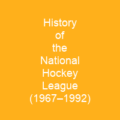Introduction to the National Hockey League (NHL)
The National Hockey League (NHL) is a professional ice hockey league composed of 32 teams – 25 in the United States and 7 in Canada. It’s considered the premier professional ice hockey league in the world, with players from 17 countries as of the 2023–24 season. The Stanley Cup is awarded annually to the league playoff champion. But how did this grand institution come into being? Let’s dive into its rich history and evolution.
The Early Years
Imagine a time when ice hockey was just taking shape, and the NHL was born out of necessity. In 1917, after the suspension of its predecessor organization, the National Hockey Association (NHA), the NHL was organized at the Windsor Hotel in Montreal.
The Original Six
From 1942 to 1967, the NHL had only six teams, nicknamed the ‘Original Six’. These teams were the Boston Bruins, Chicago Black Hawks, Detroit Red Wings, Montreal Canadiens, New York Rangers, and Toronto Maple Leafs. Each team played a crucial role in shaping the league’s identity.
Expansion and Growth
The NHL expanded to the United States in 1924, marking its first step towards becoming a truly national sport. By 1967, it had grown to include 12 teams, with the addition of Los Angeles Kings, Minnesota North Stars (now Dallas Stars), and St. Louis Blues.
Key Moments in Expansion
In 2017 and 2021, the NHL added two more teams, bringing the total to 32. The Vegas Golden Knights were established for the 2017–18 season, followed by the Seattle Kraken joining in the 2021–22 season. This expansion not only brought new markets but also increased the league’s global appeal.
The Battle of the Leagues
In the mid-1970s, the NHL faced a fierce competitor with the formation of the World Hockey Association (WHA). The battle for players and markets was intense, leading to a historic merger in 1979. This merger saw the WHA cease operations while the NHL absorbed four teams: Winnipeg Jets, Edmonton Oilers, Hartford Whalers, and Quebec Nordiques.
Key Players and Events
Wayne Gretzky played one season in the WHA for the Indianapolis Racers before joining the Edmonton Oilers. His impact on the league was monumental, leading the Oilers to four Stanley Cup championships from 1984 to 1988.
The Modern Era
Since the late 20th century, the NHL has seen significant changes in its structure and operations. The league’s headquarters have been in Manhattan since 1989, and it has undergone four league-wide work stoppages since 1992.
Recent Developments
In April 2024, the Arizona Coyotes suspended operations and sold their assets to a new team in Salt Lake City, Utah. Two months later, the Coyotes ceased efforts to re-activate within the five-year window granted to do so, bringing the NHL back to 32 franchises.
Player Safety and Inclusivity
Player safety has become a major issue in the NHL. Concussions resulting from hard hits are a primary concern. Brendan Shanahan was hired to lead player safety efforts, leading to suspensions for high-profile perpetrators of dangerous hits.
Inclusivity and Diversity
The league has made strides in inclusivity, with Marguerite Norris becoming the first female NHL executive and Manon Rhéaume becoming the first woman to play a game in any major professional North American sport. In 2019, the NHL hired its first female referees.
League Structure
The league consists of 31 teams, divided into two conferences: the Eastern Conference and the Western Conference. Each conference is split into two divisions: the Eastern Conference contains 16 teams (eight per division), while the Western Conference has 15 teams (seven in the Central and eight in the Pacific).
Recent Realignment
The league temporarily realigned for the 2020–21 season but returned to the previous alignment the following year. With the addition of the Seattle Kraken in 2021–22, all four divisions now have eight teams each and both conferences have 16 teams.
Financials and Sponsorships
According to Forbes, in 2023, the top five most valuable teams were four of the ‘Original Six’ teams and the Los Angeles Kings: Toronto Maple Leafs – US$2.8 billion, New York Rangers – US$2.65 billion, Montreal Canadiens – US$2.3 billion, Los Angeles Kings – US$2 billion, Boston Bruins – US$1.9 billion.
Corporate Partnerships
The NHL has corporate sponsors including Discover Card, Visa, Tim Hortons, Dunkin’ Donuts, Kraft Hockeyville, and SAP. In 2021, the league announced a multi-year partnership with Betway.
Broadcasting Rights
For broadcasting rights, CBC’s Hockey Night in Canada has been a tradition since 1952. Rogers Communications holds national television and digital rights valued at C$5.2 billion. Quebecor Media holds French-language rights to the NHL.
National Coverage
In the US, the NHL primarily aired on cable television before 1995. National coverage was split between broadcast and cable from 1995-2004, then NBC and OLN (later renamed Versus, then NBCSN) from 2004-2021. The current national rights are held by ESPN and TNT Sports for the 2021-22 season.
Conclusion
The National Hockey League has come a long way since its inception in 1917, evolving into one of the most prestigious sports leagues in North America. From its humble beginnings to its current status as a global phenomenon, the NHL continues to captivate fans with its thrilling games and legendary players.

You want to know more about National Hockey League?
This page is based on the article National Hockey League published in Wikipedia (retrieved on January 22, 2025) and was automatically summarized using artificial intelligence.







